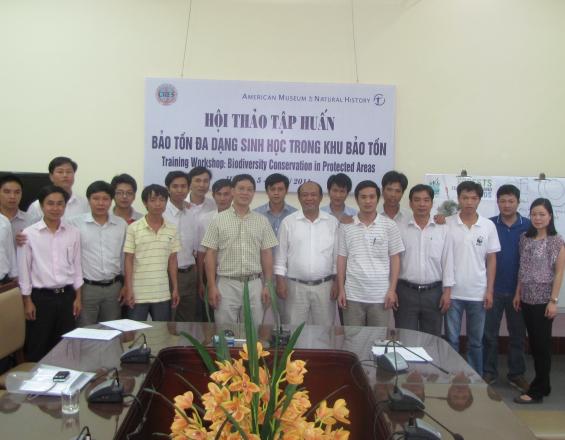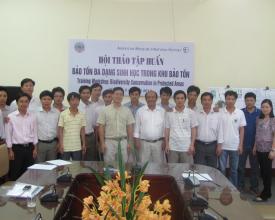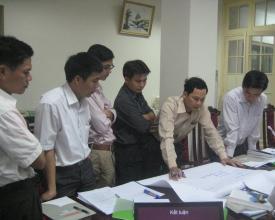Creación de capacidad en conservación de la biodiversidad y gestión de AP en Vietnam

En Vietnam se ha creado un sistema de zonas protegidas principalmente para hacer frente a los problemas de sobreexplotación y pérdida de hábitats. Sin embargo, las presiones sobre la biodiversidad y las AP se han hecho cada vez más variadas y graves en las últimas décadas. Esta solución se centró en el diseño y la puesta en marcha de un programa piloto de formación en conservación de la biodiversidad y gestión de áreas protegidas para trabajadores de la conservación del país, con el fin de ayudarles a gestionar eficazmente las AP.
Procesar
Resumen del proceso
Pudimos aumentar la capacidad en las AP vietnamitas alineando los tres bloques de construcción descritos anteriormente: evaluando las necesidades de formación, diseñando después el plan de estudios de formación y los materiales de formación de apoyo personalizados en respuesta a esas necesidades y, por último, llevando a cabo la formación a nivel local utilizando ese plan de estudios como base y modalidades intensivas y activas. Los profesionales de la conservación y los gestores de AP aprendieron técnicas, conocimientos y herramientas fundamentales para la conservación, como SIG, estudio y seguimiento de la biodiversidad y aplicación de la ley, y compartieron sus experiencias a través de distintas actividades en clase. Los recursos se han distribuido ampliamente entre los profesionales de la conservación y los gestores de AP, y se han utilizado en otros cursos de formación en todo el país. A medida que se siguen utilizando, están creando capacidad en conservación de la biodiversidad y gestión de AP para un cuadro de profesionales de la conservación, mejorando la conservación de la biodiversidad y el desarrollo sostenible dentro del sistema de AP. El ciclo de evaluación de las necesidades de formación, diseño de planes de estudio y materiales, y formación puede repetirse en el futuro a medida que cambien las necesidades de formación.
Bloques de construcción
Evaluación de las necesidades de formación
Factores facilitadores
Lección aprendida
Cursos intensivos y activos de formación en gestión de AP
Factores facilitadores
Lección aprendida
Taller de diseño curricular
Factores facilitadores
Lección aprendida
Impactos
El proyecto reforzó la capacidad profesional en gestión de áreas protegidas y conservación de la biodiversidad en AP de todo Vietnam. Los cursos de formación proporcionaron una plataforma para debatir las amenazas a la conservación en el país y en la región, con el fin de ayudar a los profesionales de la conservación a comprender la complejidad de los problemas de conservación y las posibles soluciones. Se dotó a los participantes de los principios fundamentales de la ciencia de la conservación, así como de las habilidades necesarias para aplicar las herramientas de conservación adecuadas a los problemas de sus AP. Muchos participantes estaban convencidos de que el programa les había ayudado a comprender mejor los conceptos de biodiversidad y conservación y, en última instancia, a desempeñar mejor su trabajo.
Beneficiarios
Gestores de AP y profesionales de la conservación y Sistema de Áreas Protegidas de Vietnam
Objetivos de Desarrollo Sostenible
Historia
Durante nuestro actual trabajo de investigación y formación en todo Vietnam, nos reunimos a menudo con los alumnos del curso en sus áreas protegidas. Muchos de ellos están muy implicados en programas de conservación de especies y proyectos de gestión de lugares a nivel local. Se han vuelto más proactivos en sus planteamientos hacia la conservación y demuestran su liderazgo sobre el terreno. Por ejemplo, el Dr. Hoa Vuong (Vuong Duc Hoa) era jefe del departamento científico en el momento del curso de formación, y se convirtió en subdirector del Parque Nacional de Bu Gia Map. Ha apoyado múltiples estudios colaborativos sobre el loris lento e iniciativas de conservación en el Parque Nacional de Bu Gia Map (en 2013, 2014) y también ha asistido a talleres recientes en Hanói sobre el plan de acción para la conservación de primates y sobre la conservación del loris lento (2016 y 2014 respectivamente). Ha dirigido varios programas nuevos de seguimiento de la conservación, especialmente de primates amenazados en el parque. Y ha apoyado mucho las iniciativas propuestas por su personal para avanzar en la conservación de la zona. Además, ahora colaboramos con varios participantes del curso en estudios de campo sobre loris, faisanes y tortugas en todo el país, incluyendo, por ejemplo, el Parque Nacional de Bu Gia Map en el sur, el Parque Nacional de Bach Ma y la Reserva Natural de Saola en la región central, y la reserva natural de Na Nang en el norte de Vietnam. Su capacidad ayuda enormemente a nuestra investigación en la obtención de valiosos datos de referencia para la conservación de taxones muy amenazados. También interactuamos con ellos en talleres de ámbito nacional, como el taller de lanzamiento del plan de acción nacional de Vietnam para la conservación de primates, organizado en Hanoi por nuestra organización en colaboración con la Administración Forestal de Vietnam, en el que las experiencias locales de nuestros becarios fueron muy importantes para fundamentar la planificación de acciones a escala nacional. Dado que la conservación de la biodiversidad en el país se enfrenta a un reto de enormes proporciones, podemos ver la esperanza en el aumento de la capacidad de los profesionales de la conservación. No cabe duda de que aceptarán el reto e inspirarán a otros.



